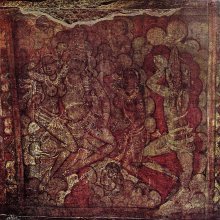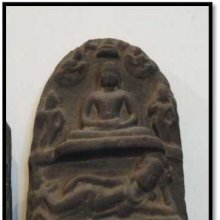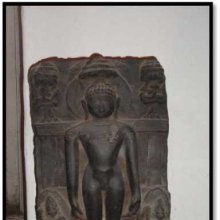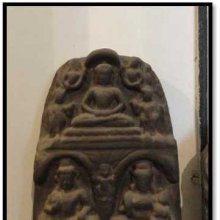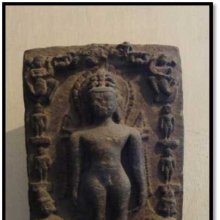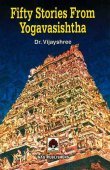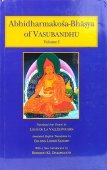Vidyadhara, Vidyādhara, Vidyādhāra, Vidya-adhara, Vidya-dhara: 29 definitions
Introduction:
Vidyadhara means something in Buddhism, Pali, Hinduism, Sanskrit, Jainism, Prakrit, the history of ancient India, Marathi. If you want to know the exact meaning, history, etymology or English translation of this term then check out the descriptions on this page. Add your comment or reference to a book if you want to contribute to this summary article.
Images (photo gallery)
(+1 more images available)
In Hinduism
Purana and Itihasa (epic history)
Source: archive.org: Puranic EncyclopediaVidyādhara (विद्याधर).—A group of semi-gods. Vidyādharas, Apsarases (celestial maids), Yakṣas, Rākṣasas, Gandharvas, Kinnaras and so on are semigods. Of these Kinnaras are lute-players, and Vidyādharas wear garlands, and all these groups live in the sky. (Agni Purāṇa, Chapter 51). It is mentioned in Mahābhārata, Ādi Parva, Chapter 56, Stanza 8, that when attracted by spells and incantations, Indra went to the Sarpasatra (serpent sacrifice) of Janamejaya, the Vidyādharas walked behind him (Indra).
Source: archive.org: Shiva Purana - English TranslationVidyādhara (विद्याधर) refers to “upholders of learning”, according to the Śivapurāṇa 2.2.42.—Accordingly, as Dakṣa bowed and eulogised Śiva:—“[...] Thou hast created the Brahmins first who uphold learning (i.e., Vidyādhara), penance and sacred rites, in order to realise the reality of the soul, O great lord, from thy mouth. Just as the master of cowherds protects the cows from adversities, so also thou art the saviour of the good. Thou art the watch and ward of Social Conventions. Thou punishest the wicked”.
Source: Cologne Digital Sanskrit Dictionaries: The Purana Index1a) Vidyādhara (विद्याधर).—Identified with Bhagavān.*
- * Bhāgavata-purāṇa VIII. 20. 31.
1b) Semi celestial beings: their creation;1 adore Indra;2 Cītraketu (Citraratha, Matsya-purāṇa) their chief;3 came to Dvārakā to see Kṛṣṇa;4 Sudarśana, a chief of;5 country of, watered by Nalinī;6 the path of.7 The performer of saubhāgyaśayana is born as a Vidyādhara.8
- 1) Bhāgavata-purāṇa II. 1. 36. 6. 14; III. 20. 44; Brahmāṇḍa-purāṇa III. 10. 38; 31. 23; IV. 20. 49; 39. 56.
- 2) Bhāgavata-purāṇa VI. 7. 4.
- 3) Ib. VI. 17. 1 and 3; VII. 8. 37; X. 3. 6; 34. 9; 62. 19; 85. 4; Matsya-purāṇa 4. 20; 8. 6; 80. 13.
- 4) Bhāgavata-purāṇa XI. 6. 3; 12. 4; 14. 5; 31. 2.
- 5) Ib. XI. 16. 29.
- 6) Brahmāṇḍa-purāṇa II. 18. 60; Matsya-purāṇa 121. 48; Vāyu-purāṇa 47. 47.
- 7) Brahmāṇḍa-purāṇa IV. 6. 13. and 22.
- 8) Matsya-purāṇa 60. 48.
Vidyādhara (विद्याधर) is a name mentioned in the Mahābhārata (cf. IX.36.21, IX.44.8) and represents one of the many proper names used for people and places. Note: The Mahābhārata (mentioning Vidyādhara) is a Sanskrit epic poem consisting of 100,000 ślokas (metrical verses) and is over 2000 years old.

The Purana (पुराण, purāṇas) refers to Sanskrit literature preserving ancient India’s vast cultural history, including historical legends, religious ceremonies, various arts and sciences. The eighteen mahapuranas total over 400,000 shlokas (metrical couplets) and date to at least several centuries BCE.
Kavya (poetry)
Source: Wisdom Library: KathāsaritsāgaraVidyādhara (विद्याधर) is a Sanskrit name referring to a group of deities, attending Maheśvara at his dwelling place, which is the mountain-peak Kailāsa (located within Himavat), according to the Kathāsaritsāgara, chapter 1. Accordingly, “There (Kailāsa) dwells Maheśvara the beloved of Pārvatī, the chief of things animate and inanimate, attended upon by Gaṇas, Vidyādharas and Siddhas.”
The Kathāsaritsāgara (‘ocean of streams of story’), mentioning Vidyādhara, is a famous Sanskrit epic story revolving around prince Naravāhanadatta and his quest to become the emperor of the vidyādharas (celestial beings). The work is said to have been an adaptation of Guṇāḍhya’s Bṛhatkathā consisting of 100,000 verses, which in turn is part of a larger work containing 700,000 verses.

Kavya (काव्य, kavya) refers to Sanskrit poetry, a popular ancient Indian tradition of literature. There have been many Sanskrit poets over the ages, hailing from ancient India and beyond. This topic includes mahakavya, or ‘epic poetry’ and natya, or ‘dramatic poetry’.
Natyashastra (theatrics and dramaturgy)
Source: Wisdom Library: Nāṭya-śāstraVidyādhara (विद्याधर) refers to a group of deities whose beard (śmaśru) should be represented as vicitra (smartly done), according to Nāṭyaśāstra chapter 23. Providing the beard is a component of nepathya (costumes and make-up) and is to be done in accordance with the science of āhāryābhinaya (extraneous representation).

Natyashastra (नाट्यशास्त्र, nāṭyaśāstra) refers to both the ancient Indian tradition (shastra) of performing arts, (natya—theatrics, drama, dance, music), as well as the name of a Sanskrit work dealing with these subjects. It also teaches the rules for composing Dramatic plays (nataka), construction and performance of Theater, and Poetic works (kavya).
Ayurveda (science of life)
Rasashastra (Alchemy and Herbo-Mineral preparations)
Source: Wisdom Library: Rasa-śāstraVidyādhara (विद्याधर) or Vidyādhararasa is the name of various Ayurvedic recipe defined in the fourth volume of the Rasajalanidhi (chapter 2, dealing with jvara: fever) and the fifth volume of the Rasajalanidhi (chapter 11, Gulma: tumour in the belly). These remedies are classified as Iatrochemistry and form part of the ancient Indian science known as Rasaśāstra (medical alchemy). Pārvatīśaṅkara is an ayurveda treatment and should be taken with caution and in accordance with rules laid down in the texts.
Accordingly, when using such recipes (e.g., vidyādhara-rasa): “the minerals (uparasa), poisons (viṣa), and other drugs (except herbs), referred to as ingredients of medicines, are to be duly purified and incinerated, as the case may be, in accordance with the processes laid out in the texts.” (see introduction to Iatro chemical medicines)

Āyurveda (आयुर्वेद, ayurveda) is a branch of Indian science dealing with medicine, herbalism, taxology, anatomy, surgery, alchemy and related topics. Traditional practice of Āyurveda in ancient India dates back to at least the first millenium BC. Literature is commonly written in Sanskrit using various poetic metres.
Chandas (prosody, study of Sanskrit metres)
Source: Shodhganga: a concise history of Sanskrit Chanda literatureVidyādhāra (विद्याधार) refers to one of the 130 varṇavṛttas (syllabo-quantitative verse) dealt with in the second chapter of the Vṛttamuktāvalī, ascribed to Durgādatta (19th century), author of eight Sanskrit work and patronised by Hindupati: an ancient king of the Bundela tribe (presently Bundelkhand of Uttar Pradesh). A Varṇavṛtta (e.g., vidyādhāra) refers to a type of classical Sanskrit metre depending on syllable count where the light-heavy patterns are fixed.

Chandas (छन्दस्) refers to Sanskrit prosody and represents one of the six Vedangas (auxiliary disciplines belonging to the study of the Vedas). The science of prosody (chandas-shastra) focusses on the study of the poetic meters such as the commonly known twenty-six metres mentioned by Pingalas.
Jyotisha (astronomy and astrology)
Source: Wisdom Library: Brihat Samhita by VarahamihiraVidyādhara (विद्याधर) refers to “singing and dancing parties”, according to the Bṛhatsaṃhitā (chapter 9), an encyclopedic Sanskrit work written by Varāhamihira mainly focusing on the science of ancient Indian astronomy astronomy (Jyotiṣa).—Accordingly, “If Venus should enter the constellation of Mṛgaśīrṣa, juice and crops will suffer; if she should enter the constellation of Ārdrā, the people of Kośala and of Kaliṅga will suffer and there will be abundance of rain. If Venus should enter the constellation of Punarvasu, the people of Aśmaka and of Vidarbha will become lawless. If Venus should enter the constellation of Puṣya, there will be good rain; singing and dancing parties will suffer [i.e., vidyādhara-raṇa-vimarda]”.

Jyotisha (ज्योतिष, jyotiṣa or jyotish) refers to ‘astronomy’ or “Vedic astrology” and represents the fifth of the six Vedangas (additional sciences to be studied along with the Vedas). Jyotisha concerns itself with the study and prediction of the movements of celestial bodies, in order to calculate the auspicious time for rituals and ceremonies.
General definition (in Hinduism)
Source: Sreenivasarao's blog: Vidhyadharas and NagasThe vidyadharas and humans deal with each other, and many humans married Vidhyadhara damsels. The Vidyadharas are essentially neutral – they cooperate with the universal hierarchy, but they neither favor nor oppose the human race.
In other Sanskrit works too , the Vidyadharas are bearers of wisdom and resemble humans in most aspects except that they are all beautiful to look at and can change forms at will. They mingle with humans and intermarry. Vidyadharas are mentioned also in the Buddhist and Jain tales .
Source: WikiPedia: HinduismVidyādhara (विद्याधर, “wisdom-holders”):—Vidyadharas are a group of supernatural beings in Hindu mythology. They possess magical powers and dwell in the Himalayas. They also attend God Shiva, who lives in the Himalayas. They are considered as Upa-devas, semi-gods. Vidyadharas also appear in buddhist sources.
In Hinduism: In the Hindu epics, Vidyadharas are described as essentially spirits of the air. They are described as doing different activities in the epics like gazing at human prowess with astonishment, strewing flowers watching a combat, rejoicing with music and laughter, crowned with wreaths and fleeing with their wives from danger. They possess great magical powers like the ability to diminish their size. They are endowed with epithets describing them as "doers of good and devoted to joy".
In Mahabharata: In the epic Mahabharata, Vidyadharas are described as following Indra with other semi-divine beings to the serpent-sacrifice of Janamejaya. In the epics, the women of the Vidyadharas, called Vidyadharis are described to possess great beauty, and were victims of kidnapping by demons like Ravana.
In Rāmāyaṇa: In Valmiki Ramayana, Sundarkanda Verses 1.22 to 1.26 describe the plight of Vidyadharas and their women following the pressure exerted on Mount Mahendra by Hanuman while taking his position in his attempt to leapcross the ocean.
In Agni Purana, they are described as wearing garlands in the sky and mentioned with other semi-divine beings like Yakshas and Gandharvas.
In the Bhagavata Purana, Citraketu is described as the king of Vidyadharas. It also tells about a cursed Vidyadhara called Sudarshana. In various references in the Purana, they are coupled with other semi-divine beings, who pray to god Vishnu for help or enumerated among the many creations of God.
In Jainism: Jain legends describe Vidyadharas as evil beings and Vipracitti is described as a demon. A third leader of the Vidyadharas is described to the wise Jambavan.
In Buddhism
Tibetan Buddhism (Vajrayana or tantric Buddhism)
Source: Wisdom Library: Tibetan BuddhismVidyādhara (विद्याधर) is the name of a Rāśi (zodiac sign) mentioned as attending the teachings in the 6th century Mañjuśrīmūlakalpa: one of the largest Kriyā Tantras devoted to Mañjuśrī (the Bodhisattva of wisdom) representing an encyclopedia of knowledge primarily concerned with ritualistic elements in Buddhism. The teachings in this text originate from Mañjuśrī and were taught to and by Buddha Śākyamuni in the presence of a large audience (including Vidyādhara).
Source: archive.org: The Indian Buddhist IconographyVidyādhara (विद्याधर) refers to a group of deities commonly depicted in Buddhist Iconography, and mentioned in the 11th-century Niṣpannayogāvalī of Mahāpaṇḍita Abhayākara.—The king of the Vidyādharas is named as Sarvārthasiddha and his form is described as:—“Sarvārthasiddha the king of the Vidyādharas is white in colourand holds in his two hands the garland of flowers”.

Tibetan Buddhism includes schools such as Nyingma, Kadampa, Kagyu and Gelug. Their primary canon of literature is divided in two broad categories: The Kangyur, which consists of Buddha’s words, and the Tengyur, which includes commentaries from various sources. Esotericism and tantra techniques (vajrayāna) are collected indepently.
Mahayana (major branch of Buddhism)
Source: De Gruyter: A Buddhist Ritual Manual on AgricultureVidyādhara (विद्याधर) occurs in three different meanings in the Vajratuṇḍasamayakalparāja.—
(1) First, in the most common way, vidyādhara refers to numerous celestial beings in the retinue of Vajradhara.
(2) Secondly, vidyādhara or spell-holder is the name of the dhāraṇī text itself, i.e. the “Vajratuṇḍasamayakalparāja”.
(3) Thirdly and finally, vidyādhara or spell-master refers to the officiant who performs the rituals prescribed in the text. This officiant is likely to be a monk here as there are references to his wearing a new robe and performing a ritual at a monastery, furthermore it is the Bhikṣus who are marked as those profiting from these activities.

Mahayana (महायान, mahāyāna) is a major branch of Buddhism focusing on the path of a Bodhisattva (spiritual aspirants/ enlightened beings). Extant literature is vast and primarely composed in the Sanskrit language. There are many sūtras of which some of the earliest are the various Prajñāpāramitā sūtras.
In Jainism
General definition (in Jainism)
Source: archive.org: TrisastisalakapurusacaritraVidyādhara (विद्याधर) refers to a group of deities living on mount Vaitāḍhya (in the northern row), according to chapter 1.3 [ādīśvara-caritra] of Hemacandra’s 11th century Triṣaṣṭiśalākāpuruṣacaritra: an ancient Sanskrit epic poem narrating the history and legends of sixty-three illustrious persons in Jainism.
Accordingly,
Source: Encyclopedia of Jainism: Tattvartha Sutra 3: The Lower and middle worlds“[...] The two rows of Vidyādhara-cities looked very magnificent, as if the Vyantara rows above were reflected below. After making [the two rows of Vidyādhara-cities], many villages and suburbs, they established communities according to the suitability of place. The communities there were called by the same name as the community from which the men had been brought and put there. [...] Dharaṇendra instructed them about the law as follows: ‘If any insolent persons show disrespect or do injury to the Jinas, or the Jinas’ shrines, or to those who will attain mokṣa in this birth, or to any ascetics engaged in pratimā, the vidyās will abandon them at once, just as wealth abandons lazy people. Whoever kills a man with his wife, or enjoys women against their will, the vidyās will abandon him at once’.”
Vidyādhara (विद्याधर) is the collective name of those human beings born on the Vijayārdha mountain, according to the 2nd-century Tattvārthasūtra 3.10. The Vijayārdha mountain stands in the middle of the Bharata-varṣa, which is a region of Jambūdvīpa: the first continent of the Madhya-loka (middle-word). What is the means of livelihood of Vidyādhara? Their occupations for livelihood are the six occupations instructed by Lord Adinātha as defense (asi), distribution and accounting (masi), agriculture (kṛṣi), education (vidyā), trade (vāṇijya) and crafts (śilpa) with the human beings called mānava.
Jambūdvīpa (where are born Vijayārdhas) is in the centre of all continents and oceans; all continents and oceans are concentric circles with Jambūdvīpa in the centre. Like the navel is in the centre of the body, Jambūdvīpa is in the centre of all continents and oceans. Sumeru Mount is in the centre of Jambūdvīpa. It is also called Mount Sudarśana.

Jainism is an Indian religion of Dharma whose doctrine revolves around harmlessness (ahimsa) towards every living being. The two major branches (Digambara and Svetambara) of Jainism stimulate self-control (or, shramana, ‘self-reliance’) and spiritual development through a path of peace for the soul to progess to the ultimate goal.
India history and geography
Source: Wisdom Library: India HistoryVidyādhara is a Sanskrit word referring “a knower of charms” and is known in Pali as Vijjādhara.
Source: What is India: Epigraphia Indica volume XXXI (1955-56)Vidyādhara is one of the Brāhmaṇa donees mentioned in the “Asankhali plates of Narasiṃha II” (1302 A.D.). When a grant was made to a large number of Brāhmaṇas, the chief amongst the donees seems to have been called Pānīyagrāhin especially. In the present record, though all the donees (e.g., Vidyādhara) are referred to as Pāṇigrāhi-mahājana, their list is headed by a Brāhmaṇa with Pāṇigrahī as his surname.
These copper plates (mentioning Vidyādhara) were discovered from the house of a Santal inhabitant of Pargana Asankhali in the Mayurbhanj State (Orissa). It was made when king Vīra-Narasiṃhadeva was staying at the Bhairavapura-kaṭaka (city, camp or residence).

The history of India traces the identification of countries, villages, towns and other regions of India, as well as mythology, zoology, royal dynasties, rulers, tribes, local festivities and traditions and regional languages. Ancient India enjoyed religious freedom and encourages the path of Dharma, a concept common to Buddhism, Hinduism, and Jainism.
Languages of India and abroad
Marathi-English dictionary
Source: DDSA: The Molesworth Marathi and English Dictionaryvidyādhara (विद्याधर).—m S A demigod or spirit of a certain order in Swarg.
Marathi is an Indo-European language having over 70 million native speakers people in (predominantly) Maharashtra India. Marathi, like many other Indo-Aryan languages, evolved from early forms of Prakrit, which itself is a subset of Sanskrit, one of the most ancient languages of the world.
Sanskrit dictionary
Source: DDSA: The practical Sanskrit-English dictionaryVidyādhāra (विद्याधार).—a receptacle of learning; असौ विद्याधारः शिशुरपि विनिर्गत्य भवनात् (asau vidyādhāraḥ śiśurapi vinirgatya bhavanāt) Mālatīmādhava (Bombay) 2.11.
Derivable forms: vidyādhāraḥ (विद्याधारः).
Vidyādhāra is a Sanskrit compound consisting of the terms vidyā and ādhāra (आधार).
--- OR ---
Vidyādhara (विद्याधर).—,
-rī f.) a class of demigods or semi-divine beings; विद्याधराध्युषितचारुशिलातलानि स्थानानि (vidyādharādhyuṣitacāruśilātalāni sthānāni) Bhartṛhari 3.7. °यन्त्रम् (yantram) an apparatus for sublimating quicksilver.
Derivable forms: vidyādharaḥ (विद्याधरः).
Vidyādhara is a Sanskrit compound consisting of the terms vidyā and dhara (धर).
Source: Cologne Digital Sanskrit Dictionaries: Edgerton Buddhist Hybrid Sanskrit DictionaryVidyādhara (विद्याधर).—(= Pali vijjādhara; in Sanskrit seems to be used only of the supernatural beings so called), magician, practitioner of magic: (Ārya-)Mañjuśrīmūlakalpa 56.23 (here used of the master of holy Buddhist magic with the use of paṭas); 58.11.
--- OR ---
Vidyādharā (विद्याधरा).—name of a rākṣasī: Mahā-Māyūrī 241.32.
Source: Cologne Digital Sanskrit Dictionaries: Shabda-Sagara Sanskrit-English DictionaryVidyādhara (विद्याधर).—m.
(-raḥ) A demigod of a particular order or class, a spirit of the air. E. vidyā a magical pill, as above, and dhara who has or holds.
Source: Cologne Digital Sanskrit Dictionaries: Benfey Sanskrit-English DictionaryVidyādhara (विद्याधर).—[vidyā-dhara], I. m. A kind of demigod, [Kathāsaritsāgara, (ed. Brockhaus.)] 1, 13. Ii. f. rī, A female demigod of this kind, [Hitopadeśa] 63, 16.
--- OR ---
Vidyādhāra (विद्याधार).—i.e. vidyā-ādhāra, m. The abode of knowledge, [Mālatīmādhava, (ed. Calc.)] 41, 2.
Source: Cologne Digital Sanskrit Dictionaries: Cappeller Sanskrit-English DictionaryVidyādhara (विद्याधर).—[masculine] a class of genii (lit. keeper of knowledge); cakravartin [masculine] king of the Vidyādharas.
--- OR ---
Vidyādhāra (विद्याधार).—[masculine] receptacle of knowledge, a great scholar.
Source: Cologne Digital Sanskrit Dictionaries: Aufrecht Catalogus Catalogorum1) Vidyādhara (विद्याधर) as mentioned in Aufrecht’s Catalogus Catalogorum:—See Cāritravardhana.
Vidyādhara has the following synonyms: Sāhityavidyādhara.
2) Vidyādhara (विद्याधर):—guru of Ānanda (Mādhavānalākhyāna). Oxf. 157^b.
3) Vidyādhara (विद्याधर):—son of Gadādhara, father of Ratnadhara, grandfather of Jagaddhara (Mālatīmādhavaṭīkā). Oxf. 136^a.
4) Vidyādhara (विद्याधर):—some jurist. Quoted in Dānamayūkha.
5) Vidyādhara (विद्याधर):—Dāyanirṇaya. Hemādriprayoga.
6) Vidyādhara (विद्याधर):—Śrautādhānapaddhati.
7) Vidyādhara (विद्याधर):—son of Lulla, poet. [Subhāshitāvali by Vallabhadeva]
8) Vidyādhara (विद्याधर):—son of Śuṣkaṭasukhavarman, poet. [Subhāshitāvali by Vallabhadeva]
9) Vidyādhara (विद्याधर):—son of Nārāyaṇa, grandson of Harihara, wrote under king Vīrabhadra of Rājakoṭa: Grahavidyādhara, in 1639. Pañcāṅgavidyādharī, in 1644.
10) Vidyādhara (विद्याधर):—son of Jagaddhara, grandson of Mūrtiśarman: Mantraratnāvalī [tantric]
Source: Cologne Digital Sanskrit Dictionaries: Monier-Williams Sanskrit-English Dictionary1) Vidyādhara (विद्याधर):—[=vidyā-dhara] [from vidyā > vid] mfn. possessed of science or spells, [cf. Lexicographers, esp. such as amarasiṃha, halāyudha, hemacandra, etc.]
2) [v.s. ...] m. a kind of supernatural being (dwelling in the Himālaya, attending upon Śiva, and possessed of magical power), fairy (-tva n.), [Harivaṃśa; Kāvya literature] etc.
3) [v.s. ...] m. (also -kavi, rācārya) Name of various scholars, [Kirātārjunīya [Scholiast or Commentator]; Vāsavadattā, [Introduction]; Catalogue(s)]
4) [v.s. ...] a kind of metre, [Colebrooke]
5) [v.s. ...] (in music) a kind of measure, [Saṃgīta-sārasaṃgraha]
6) [v.s. ...] f(ā and ī). Name of a Surāṅganā, [Siṃhāsana-dvātriṃśikā or vikramāditya-caritra, jaina recension]
7) Vidyādhāra (विद्याधार):—[from vidyā > vid] (yādh) m. ‘receptacle of kn°’, a great scholar, [Mālatīmādhava]
Source: Cologne Digital Sanskrit Dictionaries: Yates Sanskrit-English DictionaryVidyādhara (विद्याधर):—[vidyā-dhara] (raḥ) 1. m. A demigod; spirit of the air.
[Sanskrit to German]
Sanskrit, also spelled संस्कृतम् (saṃskṛtam), is an ancient language of India commonly seen as the grandmother of the Indo-European language family (even English!). Closely allied with Prakrit and Pali, Sanskrit is more exhaustive in both grammar and terms and has the most extensive collection of literature in the world, greatly surpassing its sister-languages Greek and Latin.
Kannada-English dictionary
Source: Alar: Kannada-English corpusVidyādhara (ವಿದ್ಯಾಧರ):—
1) [noun] a man skilled in any science; a scholar.
2) [noun] a class of gods believed to be experts in various arts and science.
3) [noun] a god belonging to this class.
4) [noun] (mus.) one of the one hundred and one time-cycles.
Kannada is a Dravidian language (as opposed to the Indo-European language family) mainly spoken in the southwestern region of India.
See also (Relevant definitions)
Partial matches: Dhara, Vidya, Adhara.
Starts with (+9): Vidyadhara acarya, Vidyadhara Chogyam Trungpa Rinpoche, Vidyadhara kavi, Vidyadhara Mishra, Vidyadhara-torana, Vidyadharabhattopadhyaya, Vidyadharabhra, Vidyadharacakravartin, Vidyadharadevata, Vidyadharadhipati, Vidyadharadhipatya, Vidyadharadhisha, Vidyadharadhishata, Vidyadharagana, Vidyadharakarana, Vidyadharakula, Vidyadharakumara, Vidyadharamahacakravartin, Vidyadharamahacakravartita, Vidyadharapati.
Ends with: Candrarekhavidyadhara, Dushtavidyadhara, Gitavidyadhara, Grahavidyadhara, Gulikavidyadhara, Khadgavidyadhara, Malavidyadhara, Rajavidyadhara, Rangavidyadhara, Sahityavidyadhara, Satyakividyadhara, Vinodavidyadhara, Vishrantavidyadhara.
Full-text (+2297): Mrigankalekha, Vaidyadhara, Muktasena, Lalitalocana, Kalakutapati, Muktaphalaketu, Kancanavega, Padmakuta, Sammardana, Rankumalin, Vijayavega, Shashikhandapada, Vidyadharibhu, Vidyadharendra, Madanavega, Mrigankasena, Prishadvara, Madanaprabha, Kamarupin, Rajatadamshtra.
Relevant text
Search found 95 books and stories containing Vidyadhara, Vidyādhara, Vidyādhāra, Vidya-adhara, Vidya-dhara, Vidyā-ādhāra, Vidyā-dhara, Vidyādharā; (plurals include: Vidyadharas, Vidyādharas, Vidyādhāras, adharas, dharas, ādhāras, Vidyādharās). You can also click to the full overview containing English textual excerpts. Below are direct links for the most relevant articles:
Garga Samhita (English) (by Danavir Goswami)
Verse 4.23.5 < [Chapter 23 - The Story of Sudarcana]
Verse 5.8.45 < [Chapter 8 - The Killing of Kaṃsa]
Verse 4.23.9 < [Chapter 23 - The Story of Sudarcana]
Trishashti Shalaka Purusha Caritra (by Helen M. Johnson)
Part 13: Story of Amitagati resumed < [Chapter II - Marriages of Vasudeva with maidens]
Part 17: Battle with Aśanivega < [Chapter VII - Sanatkumāracakricaritra]
Part 2: Rāvaṇa’s marriage < [Chapter II - Rāvaṇa’s expedition of Conquest]
The Skanda Purana (by G. V. Tagare)
Chapter 11 - The Greatness of Vidyādhara Tirtha < [Section 1 - Avantīkṣetra-māhātmya]
Chapter 8 - Sudarśana Becomes a Vampire < [Section 1 - Setu-māhātmya]
Chapter 76 - The Power of Trilocana < [Section 2 - Uttarārdha]
Kathasaritsagara (the Ocean of Story) (by Somadeva)
Chapter XLVIII < [Book VIII - Sūryaprabha]
Chapter CX < [Book XV - Mahābhiṣeka]
Chapter CVII < [Book XIV - Pañca]
Yoga Vasistha [English], Volume 1-4 (by Vihari-Lala Mitra)
Chapter XVI - Extinction of vidyadhara (continued) < [Book VII - Nirvana prakarana part 2 (nirvana prakarana)]
Chapter VI - Description of disaffection and disgust to the world < [Book VII - Nirvana prakarana part 2 (nirvana prakarana)]
Chapter CXII - Flight of the foreign foes < [Book VII - Nirvana prakarana part 2 (nirvana prakarana)]
Gati in Theory and Practice (by Dr. Sujatha Mohan)
Gati in aerial sphere < [Chapter 3 - Application of gati in Dṛśya-kāvyas]
Elucidation of Karaṇas related to Gati < [Chapter 2 - Concept and technique of Gati]
Relevance of Gati in Rūpakas < [Chapter 3 - Application of gati in Dṛśya-kāvyas]
Related products
